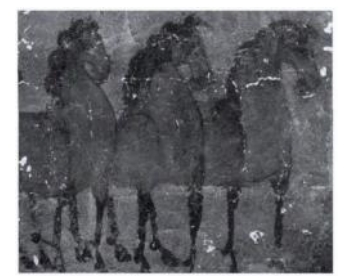
Published 08-01-2025
Keywords
- horse mouth,
- flat,
- pointed,
- Jiu yuan Gang
Copyright (c) 2025 Cambridge Arts and Humanities Research

This work is licensed under a Creative Commons Attribution-NonCommercial 4.0 International License.
Abstract
Han dynasty literature records that the ancient sage Gao Yao's "horse mouth symbolizes utmost sincerity," using the flat and square shape of the horse's mouth to represent judicial fairness and justice. In reality, as well as in ancient murals, the depiction of horse mouths is predominantly flat. However, the Tang dynasty art historian Zhang Yan yuan mentioned in "Records of Famous Paintings" that "ancient paintings depict pointed horse mouths," which is quite rare. For example, in the murals of the tomb of Jiu yuan Gang in Xin Zhou, the horse mouths are all pointed.
References
- Liu An. Complete Translation of Huainanzi [M]. Translated and annotated by Xu Kuang Yi, Guiyang: Guizhou People's Publishing House, 1993: 1144.
- Liu An. Complete Translation of Huainanzi [M]. Translated and annotated by Xu Kuang Yi, Guiyang: Guizhou People's Publishing House, 1993: 1147.
- Xing Zhao yuan, Li Jian bin. Divine Beasts, Tigers, Youthful Riders, and Eagles Wrestling Hares—The Murals of Xin Zhou Tombs Unleash a Hunting Wind [N]. Guang Ming Daily, 2013-12-27(09).
- Yang Zhi shui. Scattered Notes on the Murals of the Northern Dynasties Tombs in Xin Zhou [J]. Popular Archaeology, 2014, 3: 72-74.
